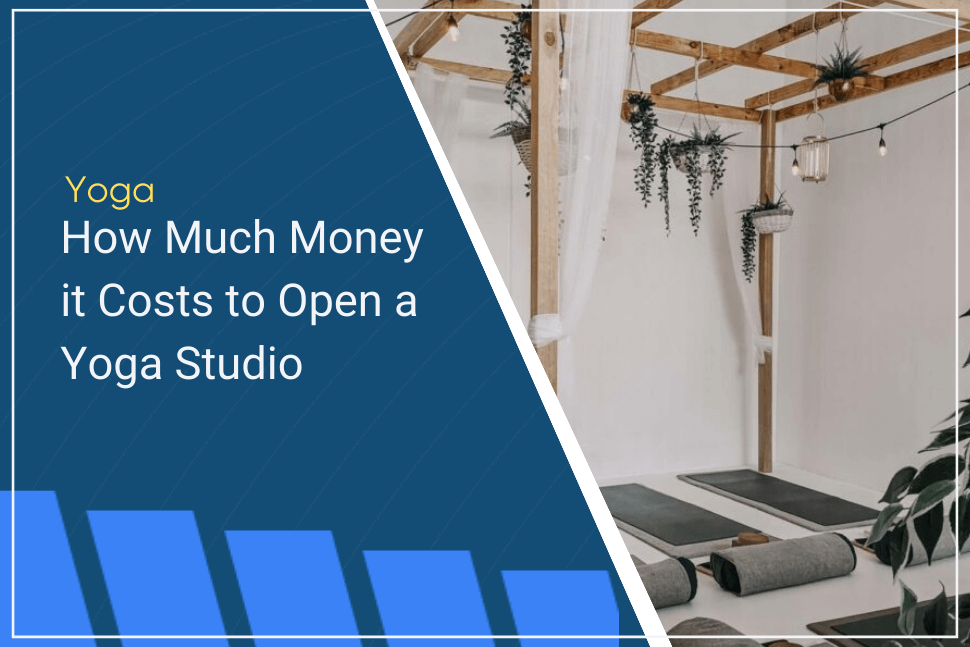Interest in yoga has grown exponentially over the last 10-15 years. A 2016 survey found that over 36 million Americans practiced yoga. People are drawn to yoga because it is more than just an exercise routine. Yoga can improve flexibility, reduce stress, and help with muscle recovery from other workouts. With all these great benefits, it’s no surprise that many yoga fans consider opening a studio of their own.
How Much Does It Cost To Open a Yoga Studio?
Compared to other fitness modalities, the cost to open a yoga studio is generally more affordable. The biggest reason is that there is very little equipment to purchase. In addition, each student only needs a small space for the class, so you don’t need as large of a studio.
Opening a yoga studio costs around $15,000 on the low end and over $100,000 for large luxury studios. You can easily open a beautiful yoga studio for less than $30,000 (in the right location).
Breakdown of Opening Costs
While yoga studio costs are lower to start when compared to other types of gyms, you can still expect to spend a chunk of money upfront.
Location
Your location is the most important factor when determining how expensive it will be to open a yoga studio. Property costs and rental rates vary immensely throughout the country. For example, a small studio space in New York City can cost substantially more than a larger small in a suburban strip mall.
Take a look at commercial lease rates in your area. These are typically listed as price per square foot per year. To host classes for 20-30 people, you’ll need around 1000 square feet of space. Multiply the price per square foot by 1000 and then divide that number by 12 to see your estimated monthly rent.
Most commercial spaces will require a security deposit for the space. This can range from 2 months’ rent to one year’s rent based on the management company and type of space. Your ongoing expenses for the location will include rent, utilities, and maintenance costs.
In addition to leasing (or purchasing) your studio space, you will most likely need to make improvements to the space. Most yoga studios add wood floors and mirrors on the wall. A nice bathroom and relaxing decorations can help complete the space. If you are leasing a newly built commercial space, you may be able to negotiate a “build-out budget” since the space will be empty. While new construction usually has higher rates, you can save on refurbishment costs.
If leasing a studio is not in your start-up budget, consider partnering with a local gym or facility and using their space. Facilities for children’s activities, such as cheerleading and gymnastics, are usually empty in the mornings when kids are at school. Oftentimes, a yoga instructor will just rent the space per class.
Equipment
This is the best part of opening a yoga studio. The equipment costs are much less than any other fitness studio. Many students choose to bring their own mat, but you can choose to have some available. Towels are a nice addition, especially if you plan to offer hot yoga classes. Students will also appreciate yoga accessories, like straps and blocks.
Overall, you can expect to spend no more than a couple of thousand dollars on equipment expenses.
Marketing
The best yoga studio means nothing if no one knows about it. Marketing is necessary for getting the word out about your new business. While you will incur ongoing costs for marketing, you can expect to spend a bit more before opening. Marketing materials alone (brochures, business cards, stickers, etc.) can cost hundreds of dollars depending on what you order and the quality of the products.
Instead of creating a website yourself, utilize a professional. People spend so much time online now that they can easily distinguish between a quality website and a poorly made one. It may not seem important, but this will be the first impression for many of your potential clients. A little extra money upfront is more than worth it.
In the age of social media, it is possible to spend very little on marketing and still effectively spread the news about your studio opening. You can manage your website and social media accounts yourself. Don’t underestimate how helpful word-of-mouth can be. It is easy to talk to other local businesses and let them know about your new studio.
Instructors
Payroll for your instructors is an ongoing expense. However, you may have upfront costs like teaching certifications and hiring advertisements. If you are the only instructor, you don’t need to worry about these costs until you plan to add more instructors.
Insurance
Before you open your doors, you’ll need to obtain commercial property insurance for your business. This covers your physical space in case of damage. As a fitness studio, it is also extremely important to obtain quality liability insurance. You want to make sure you are protected in case of any injury lawsuits against your studio.
While insurance is an ongoing expense, you’ll need to have it all squared away before you open your yoga studio.
Business License and Permits
To open any business, you need to first obtain a business license through your state. The cost varies by state but is usually less than $200.
Local permits will also vary based on your location. Your local chamber of commerce can usually help with identifying all the specific permits you may need. Don’t forget to look into special permits that may pertain to your yoga studio, including food and retail seller permits. Some areas even require special permitting if your studio has a shower for clients to use.
Opening Event
You don’t need to host an opening event for your business, but it can be a nice way to entice potential customers to check out the space. An event also doesn’t need to be that expensive. For little to no cost, you can host an open house with a couple of complimentary short classes. Add-ons, like catered food or beverages and children’s entertainment, can increase the cost but also attract more people to come.
Ongoing Yoga Studio Expenses to Plan for
After the initial costs to open your yoga studio, you’ll have ongoing expenses that keep your business running. When planning to open your studio, it can be helpful to take a look at your ongoing expenses in addition to the initial costs.
Payroll
If you employ instructors (or any other employees), this can be one of your biggest expenses. Continuing education and additional certifications can also be added expenses for your yoga teachers.
Taxes
Business taxes are structured differently than personal taxes. Check with your local Department of Revenue to find out when you need to file and pay taxes. Remember that you’ll also be responsible for withholding taxes from your employee paychecks and sales tax from merchandise items.
Merchandise/Food & Beverage
If your yoga studio sells merchandise, you’ll most likely be paying for these items up front and then selling them to your members. This can be a large expense as you order your inventory. You can also sell beverages and food items, like protein bars or smoothies, to your members. You’ll need to purchase the inventory throughout the year.
Yoga Studio Software
Using good yoga studio management software will be more than worth the cost. Programs, like Gymdesk, manage your memberships, provide automated billing, and track merchandise inventory. This software doesn’t have to cost an arm and a leg. Gymdesk is affordable and its subscriptions are all-inclusive of its features.
How to Open a Yoga Studio with No Money
It’s possible to start a Yoga Studio with no money if you think creatively and are willing to operate in an unorthodox way.
First, you’ll need to tap into your personal network to see who is willing to take yoga lessons from you. Family, friends, coworkers, and anyone they know who might be interested.
The logic for this is simple: it’s people who already know and like you, it costs nothing, and they’re less likely to sue you.
That said, it’s still recommended to operate with a liability insurance policy. They tend to be pretty cheap, even as low as $20 a month.
Second, secure a no-cost place to conduct your yoga sessions. Parks are fantastic, but they aren’t always reliable due to weather or big events. Homes can work, too, and can be more reliable. If you live in an apartment complex, the workout room might be an option.
Third, be sure to collect something from your initial yoga students. It’s okay to offer free classes to try you out, but they can’t practice with you for free indefinitely. You have to collect fees.
Finally, take those fees you collect, and start putting it into building your yoga studio in a professional business step-by-step.
For more information, read our article on how to start a yoga studio.
Final Thoughts
The costs associated with opening a yoga studio are going to vary on several things, including your location, the size of your studio, and how many instructors you employ. Many new studio owners have been able to open their businesses for under $30,000. Expenses that contribute to this total are security deposits on your space, equipment, marketing, insurance, and more. In addition to the start-up costs, it is important to also prepare for your ongoing expenses, like payroll and taxes. Overall, opening a yoga studio can be more affordable and easier than you think.
 Gym Owner Statistics: The State of Gyms, Member Trends, and Usage Data
Gym Owner Statistics: The State of Gyms, Member Trends, and Usage Data



